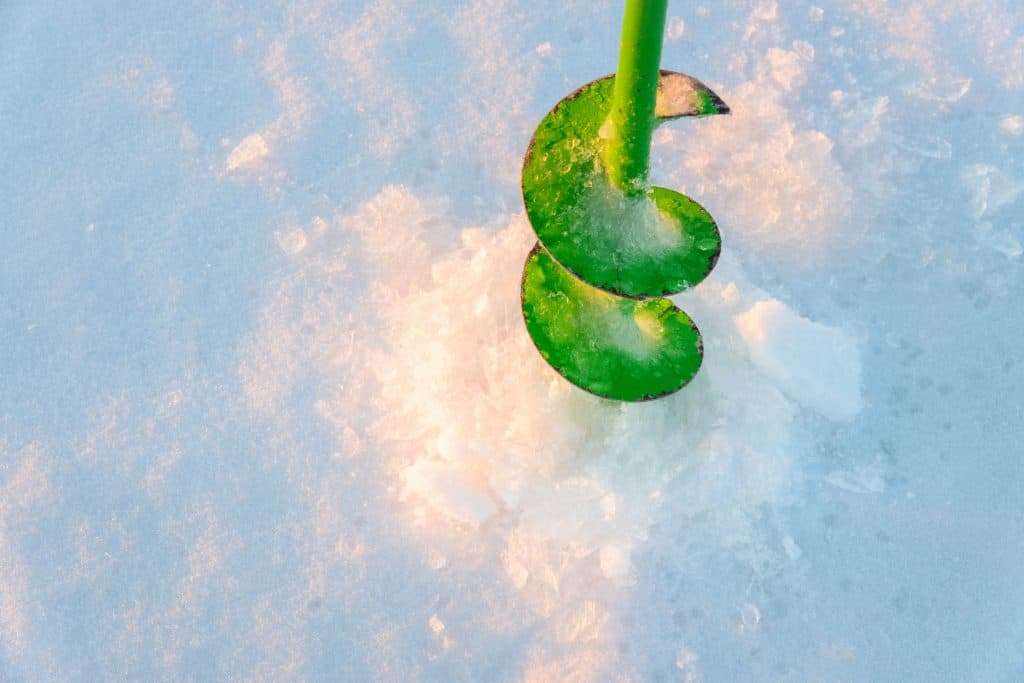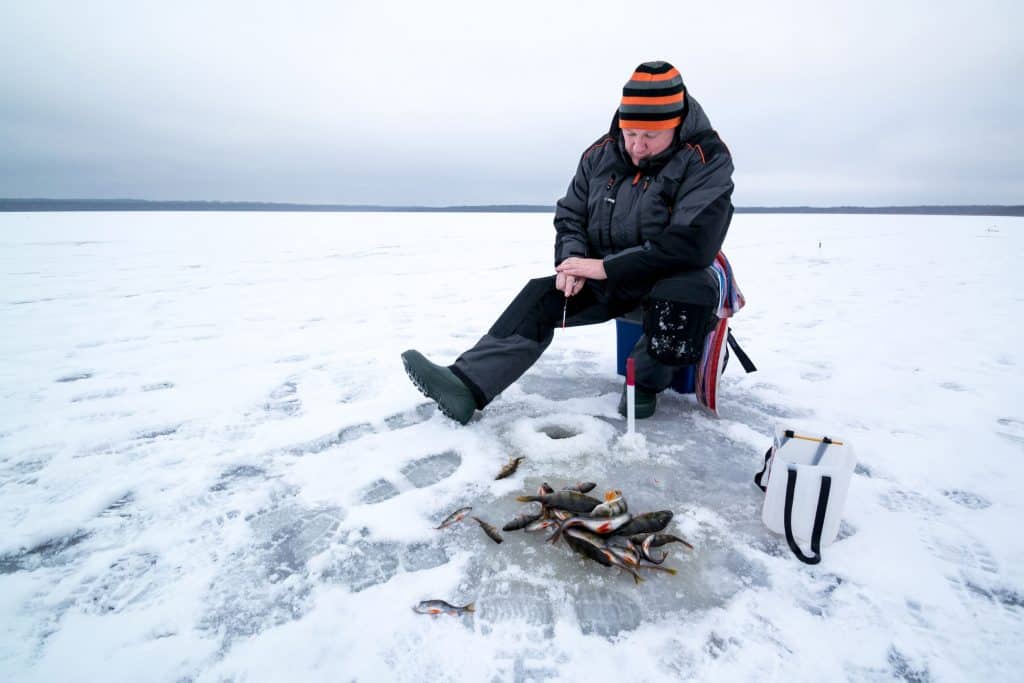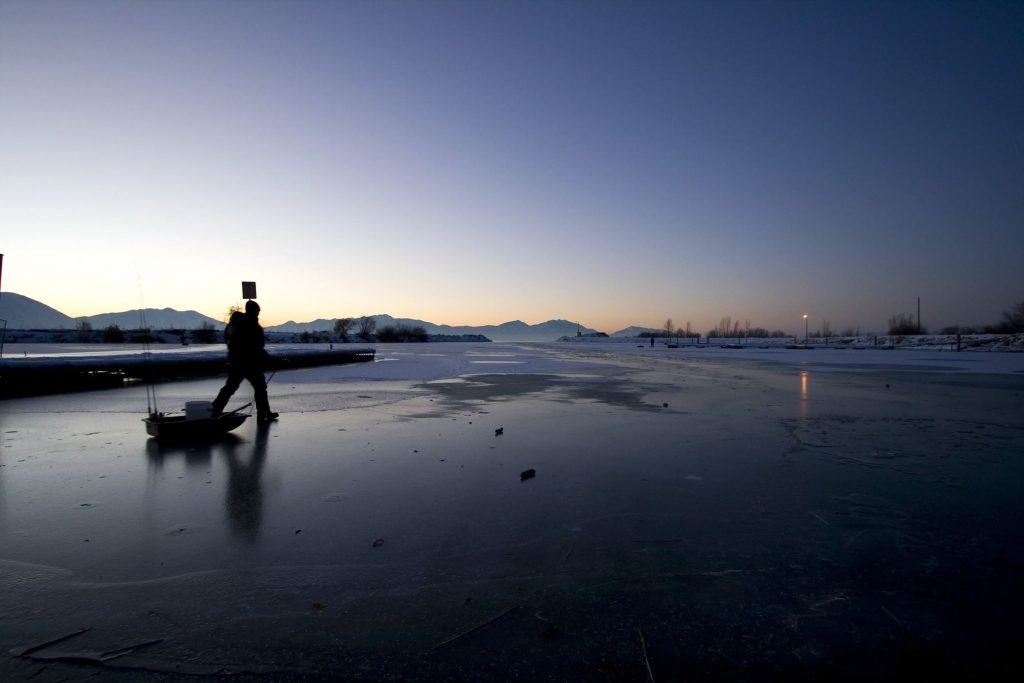
Let’s say you are going to go ice fishing. This is a relatively new thing for you and that is why you have come to this article. How do you know what size is right?
Create a hole about 6-8 inches in diameter. Finding the right size really depends on the kind of fish you want, the time you spend out on the ice, and the gear you have. Decisions should be made well in advance to avoid spending needless energy on the ice.
Before you even get in your car the morning you go ice fishing, you should have a plan. In order to maintain good energy levels and be safe, you need to know what you are planning on fishing for. It is important to know the size of the fish, how many holes you plan on making, and how long you plan on being out on the ice.
Your Ice Fishing Style Determines the Size and How Many Holes You’ll Make
Determining your ice fishing hole size is no joke. If you want a general size, I would say 6 to 8 inches. I suggest planning out your trip in advance so you know what size and how many holes you want. The kind of fish, how much fish, and how many hours you spend on the ice will, in a large amount, affect the size of the hole that you desire.
A huge factor in the size of the hole is what kind of ice auger you use.
What Kind of Auger Do You Want to Use?
There are 3 different kinds of ice augers out there: manual, gas, and electrical.
For years people used manual ice augers. It was purely based on your strength to cut holes in the ice. Many people still use them and some places only allow you to use manual ice augers. These are your most basic and simple versions out there. They are also the cheapest.
With the advancement of the modern age, we have been extremely fortunate to have gas and electrical ice augers. They have made cutting through the ice a lot easier and less physically demanding.
So what does any of this mean for you when it comes to hole size?
How big is your adventure going to be? Are you going to be catching many fish with many holes are you going to have a super chill day (no pun intended) on the ice with your shanty, one line, and one hole?
Believe it or not, that all has a role to play in the kind of auger you want. If you are planning on only a very small amount of holes and not expending too much effort on your part, I would go with a manual auger. Manual augers are cheaper for the kind of ice fishing you are going to do. Plus, with only one hole you will not waste as much energy.
Another reason to use a manual auger would be that it is lighter and any ice fisher knows that they want to pack light, especially if they are not bringing their truck on the ice.
Gas and electric augers are really incredible inventions. They will make your trips easier if you plan on catching many fish. Most ice fishers can handle making a few holes in the ice by themselves. But eventually it wears them down and that makes ice fishing not enjoyable. If you are going to create lots of holes, use a gas or electric auger. That is my advice to you.
The only thing extra I will say is that gas and electric augers are not light and they do not really fit in the realm of packing light. I would say that they are more for those who go in groups or have a lot of experience on the ice. Either way, that is just my two cents.

How Long Will You Be Fishing?
It is important to plan out your ice fishing trips for your own safety and comfort.
It is important to think about how long you are going to be fishing. If you have lots of holes and tip-ups that you run around to throughout the day, you will get tired. The cold also takes a lot out of you because your body has to create more heat to keep you warm which means more energy is spent.
Obviously, I suggest bringing food but that is not my point. My point is that you will need to plan out what kind of ice fishing trip this will be because you only have so much energy to use.
If you use a manual ice auger, what size of hole are you going to cut? How many? The bigger the hole, the more energy you have to spend. Multiply that by how many holes and you will need a few protein bars. That’s what I eat when I am out ice fishing.
With gas and electric augers, you will need to bring extra juice for when you run out. The amount will depend on how much time you spend out there creating holes. The size and number of holes are something to think about when getting extra juice for your auger. I hope that you can see the reason why I say plan ahead for your trips.
How much time and energy do you want to spend on the ice cutting holes? Making holes determines where you will set up camp. What if the area of the lake you are fishing is not good and no fish are catching? You will have to set up camp in another area. To me that is nothing but annoying.
After you find the sweet spot, then you have to drill more holes. It is a process that can either wear you out or deplete the gas and electrical power you brought with you.
The Hole Will Gradually Become Smaller
Something to factor into your hole size making decision is that over time the hole will begin to freeze again throughout the day. The bigger the hole, the longer it will be before you have to cut it again. Now, this is important if you plan on spending most of the day out on the ice. If you do not like the idea of cutting once or twice throughout the day, then I suggest making a bigger hole.
The Size of the Hole Depends on the Fish You Want
Determine the circumference and diameter of the hole by the kind of fish you want to catch.
What kind of fish are you trying to catch? I would not suggest whimsically choosing to fish for whatever comes your way. Some fish are taller or wider than others. I think most fish you will catch will be in the 6 to 8-inch range.
Plenty of people can fish for panfish and pull them out of a 6-inch hole with no problem. A crappie, on the other hand, would be difficult because crappies are taller than they are wide. Their width would fit but their height would not. 8 inches is better for crappie. When deciding on the fish you want to catch, consider the circumference and the diameter of the hole.
If the hole is not big enough, you might get some fish stuck and you will lose out on a trophy fish. Nothing hurts worse than having to let one get away, trust me. If you plan on catching fish on the smaller end of the spectrum, go for 6 inches. On the larger end, go for 8 inches. If you are really feeling adventurous, go for 10 to catch the really big fish.
Well, why not make the hole as big as possible? Well, you could but let’s consider a few things. First off, bigger holes will require more energy. Secondly, you can lose fish through bigger holes.
What? I just told you that you can get fish stuck and now I am saying you can lose them? Yeah, it happens. A fish will slip out of your hand and then wiggle into a 10-inch hole and you will never see them again. If that is not a buzzkill, I do not know what is.
How Does the Ice Depth Affect the Hole Size?
Cutting through inches of ice takes a lot of energy. Make sure you plan well beforehand.
Ice has a big influence on how you ice fish. Let’s say you want to cut a hole with a diameter of about 8 inches for a really big fish. Well, a hole that big is about 25 inches in circumference. That is a lot of ice to go through. Then, let’s add in how deep the ice is. Let’s say it is about 6 inches deep. That is just barely over 300 cubic inches of ice. That is a lot of ice.
Does it make sense now why I say that ice depth has an effect? If you were to cut 10 holes in the ice, that would be 3000 cubic inches of ice you are cutting through. It takes a lot of energy/juice. That is all the math I will be doing today.

This is why I say to bring a gas or electric auger for big outings. That would honestly be too much manually unless you had a lot of friends going with you and could take turns cutting the ice. Don’t you wish that we had laser cutters for ice? That would be so cool.
My big lesson and what I hope you will get out of this is to consider the kind of energy you will have to use in order to cut ice. Plan beforehand and bring friends if you need to.
Too Much Light From a Hole Can Scare Away Fish
Some fish just do not like light. Fish sometimes will shy away from it. This is mostly a problem with crappie. That is what I have noticed. I have mentioned before to throw ice chunks or shards into the hole to block some light but that might not always be the best option. Putting some distance between holes is a good idea.
The bigger the hole, the more light you let in. At night this thankfully will not be as big of a problem. Unless you have flood light or something stupidly bright, then you should not be too worried about this. I also suggest spacing out your holes. I think that five feet apart is a good amount. If you are setting up tip-ups, this is what I suggest doing:
Once you have found the place to set up base camp, cut holes in a line a couple of feet apart that are in the line of sight. That way you can take quick looks at your tip-ups without having to move. If one of your flags drop, you will know instantly. I have found this to be extremely efficient.
Hazards that Come with Bigger Holes in the Ice
The bigger the hole in the ice is, the more chances of losing a fish and/or having something bad happen increases. A 10-inch hole is more dangerous than a 6-inch hole. I have heard about some weird things that have happened from older anglers have shared their stories.
I have heard many stories from the lips of other anglers about tripping. Tripping can be dangerous. Hitting the ice hard is never something anybody wants to experience. You could break a bone or gash your head pretty good. I had someone once tell me how they twisted their ankle pretty good from tripping on a big hole in the ice. Sometimes you can’t see them that well.
Sometimes there is a lot of snow or ice shards that it does not look like there is a hole there. Other times the hole could be partially frozen over and you step on it and it gives way. That one is honestly my biggest fear when I ice fish. Being caught off guard is one of my least favorite things.
I have done this before and I have heard of others losing things to the depths of the water. Sometimes you lose gear in the most random and infuriating ways. Those chances are increased when you have created a bigger hole. If you have multiple, there are even more chances.
I have lost little things plenty of times like jigs. Of course, you can find plenty of lures for cheap. It is still frustrating. I have seen people lose their bait sometimes. Sometimes you bump the table and there goes your stuff. You only hope it does not fall into the hole you created.

If you are not currently fishing, I suggest covering the hole. Mainly because you will not lose things unnecessarily to the water and it will block light getting into the water. Maybe you are attaching a new line or just taking a break. Either way, it makes your life easier to cover up the hole when you are not using it.
The scariest thing I have heard of is kids falling in the hole. I have never heard of a kid falling all the way through but even up to the waist is scary. I do not have kids but if that happened to a hypothetical kid of mine, I do not think I would bring them back for a while. The bigger the hole, the more chances.
It is also dangerous because then you have to get a change of clothes, fast. Hypothermia would kick in really fast if they do not get warm. When you are pretty far out on the lake, this becomes a scary situation fast. Personally, if I were to bring kids, I would keep the holes to a minimum and reduce the size of the holes. 6 inches for a hole would be big enough but not too big to have your child fall completely in the water.
